A loose door latch can be a minor annoyance that gradually becomes a significant inconvenience, affecting the security and functionality of your doors.
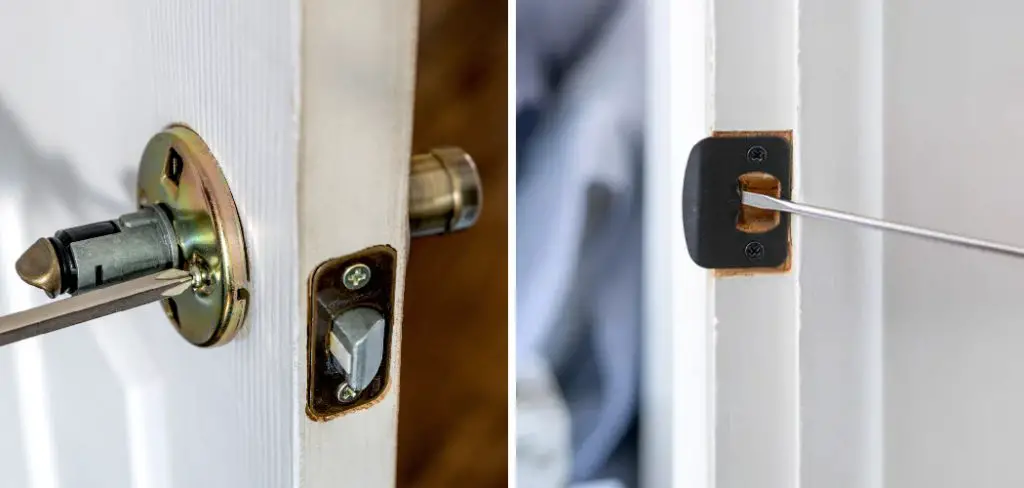
Whether it’s a front door, interior door, or even a cabinet door, a loose latch can prevent the door from closing properly, leading to drafts, noise, and potential security risks.
Fortunately, fixing a loose door latch is a relatively straightforward task that can be accomplished with a few simple tools and some basic know-how.
This guide will walk you through the process of how to fix a loose door latch, whether it’s due to loose screws, misalignment, or worn-out components, and provide clear, step-by-step instructions on how to address each issue.
By following these practical tips, you can restore the proper function of your door latch, ensuring your doors close securely and operate smoothly. Say goodbye to the frustration of a door that won’t latch properly and enjoy the peace of mind that comes with a job well done.
The Importance of a Secure Door Latch
A secure door latch is essential for several reasons, ranging from safety and security to energy efficiency and comfort. First and foremost, a properly functioning latch ensures that your door closes and locks as intended, offering a crucial barrier against unauthorized entry.
This is especially important for exterior doors, where a loose latch can render even the sturdiest lock ineffective. Beyond security, a well-aligned door latch prevents drafts and temperature fluctuations by ensuring a tight seal.
This can significantly enhance energy efficiency, reducing heating and cooling costs and maintaining a comfortable indoor environment. Additionally, a secure latch contributes to the overall structural integrity of the door, preventing undue wear and tear on the hinges and frame.
This prolongs the life of your door and helps avoid the cost and hassle of premature repairs or replacements. Clearly, maintaining a secure door latch is not just about convenience; it’s a vital aspect of home maintenance that safeguards your property and contributes to your overall well-being.
Common Causes of a Loose Door Latch
Several factors can contribute to a loose door latch, each requiring different approaches to resolve. Here are some of the most common causes:
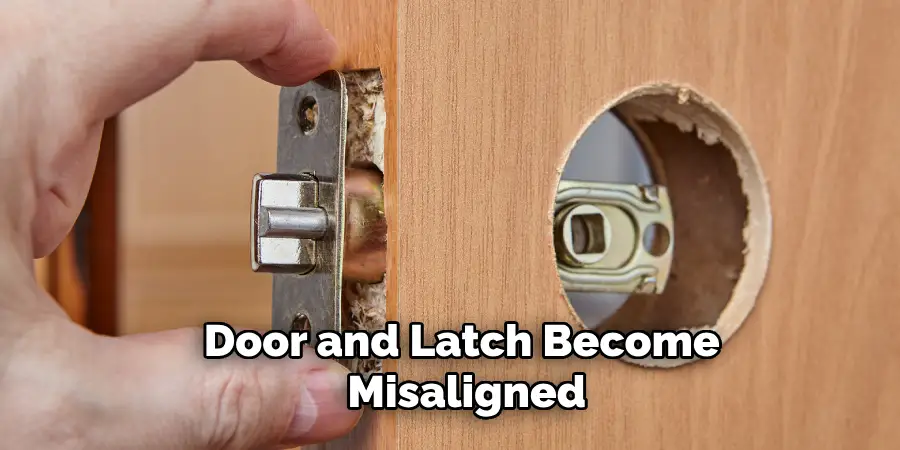
- Loose Screws: Over time, the screws that secure the latch plate or strike plate to the door or frame can become loose due to regular use, vibrations, or changes in temperature and humidity. When these screws are not tight, the latch mechanism can shift out of place, preventing it from engaging properly.
- Misalignment: Sometimes the door and latch become misaligned, which can happen due to settling of the house, warping of the door or frame, or improper installation. This misalignment can cause the latch to miss the strike plate or not fully engage, leading to a loose and ineffective latch.
- Worn-Out Components: The latch mechanism itself, including the latch bolt or strike plate, can wear out over time due to friction and repeated use. Worn components may not fit together precisely, resulting in a loose latch that doesn’t function as intended.
- Weather and Temperature Changes: Significant changes in weather or temperature can cause wooden doors and frames to expand or contract. This natural movement can affect the positioning of the latch and strike plate, leading to a loose fit and preventing proper closure.
- Improper Installation: If the door latch was not installed correctly to begin with, it could become loose more quickly. This includes using the wrong type of screws, not drilling pilot holes, or failing to ensure that all components are properly aligned.
By identifying and understanding these common causes, you can more effectively address and prevent issues with a loose door latch, ensuring that your doors function smoothly and securely.
Understanding the Components of a Door Latch
To effectively fix a loose door latch, it helps to understand the key components involved. A typical door latch assembly consists of several parts, each playing a critical role in ensuring the latch functions properly:
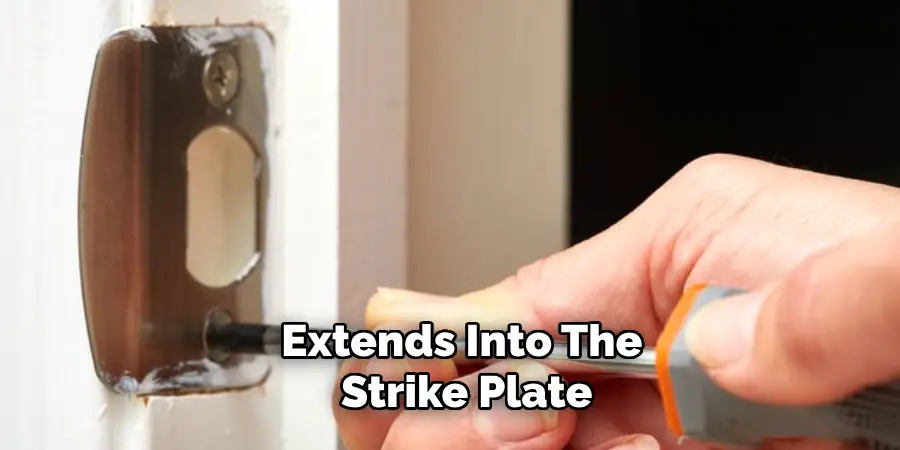
- Latch Bolt: This is the part of the latch that protrudes from the edge of the door and extends into the strike plate. When you turn the doorknob or use the key, the latch bolt retracts, allowing the door to open.
- Strike Plate: Mounted on the door frame, the strike plate is a metal plate with a hole that accommodates the latch bolt when the door is closed. It helps guide the latch bolt into the proper position to secure the door.
- Latch Plate: Also known as the faceplate or edge plate, the latch plate is attached to the edge of the door, covering the latch mechanism and providing a clean finish. It helps to secure the latch bolt in place within the door.
- Deadbolt (Optional): In some doors, especially exterior ones, there is an additional deadbolt lock for extra security. The deadbolt is a thicker, stronger bolt that operates separately from the latch bolt to provide a higher level of protection.
- Screws: These are used to secure the latch plate, strike plate, and latch mechanism. Ensuring that these screws are tight and properly aligned is crucial for the smooth operation of the door latch.
- Doorknob or Handle: The doorknob or handle allows the user to operate the latch bolt. When turned or pressed, it retracts the latch bolt, permitting the door to open.
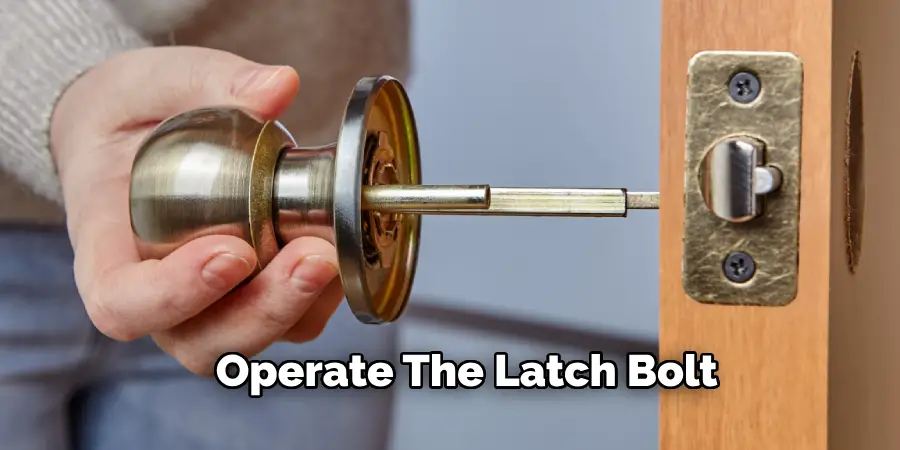
By familiarizing yourself with these components, you can more easily diagnose which part may be causing a loose latch and take the necessary steps to repair it. Understanding how each piece fits and works together provides valuable insight into maintaining and troubleshooting your door latch system.
Common Issues That May Cause a Loose Door Latch
Addressing a loose door latch often requires identifying the root problem. Here are some common issues that may cause your door latch to become loose and ineffective:
- Worn or Damaged Strike Plate: The strike plate is subject to repeated contact with the latch bolt, causing it to wear down over time. This wear and tear can result in a misalignment between the latch bolt and the strike plate, leading to a loose fit.
- Loose or Stripped Screws: Screws that secure the latch components can become loose from constant use or could be stripped due to over-tightening. Stripped screws lose their ability to hold the components firmly together, which can result in a shaky and insecure latch.
- Door Sagging: Over time, the weight of the door can cause it to sag, changing its alignment with the door frame. A sagging door may cause the latch bolt to misalign with the strike plate, preventing proper engagement.
- Incorrect Door Installation: If the door or its latch components were not installed correctly, this can cause ongoing alignment issues. An improperly installed door or strike plate may never properly align, leading to a persistent loose latch problem.
- Temperature and Humidity Fluctuations: Variations in temperature and humidity can cause wood to expand or contract. These changes can affect the alignment of the door and the position of the latch engagement, contributing to a loose latch.
- Accumulation of Dirt and Debris: Dirt, dust, and other debris can build up inside the latch mechanism or around the strike plate. This accumulation can hinder the latch bolt’s ability to fully engage, causing the latch to function less effectively.
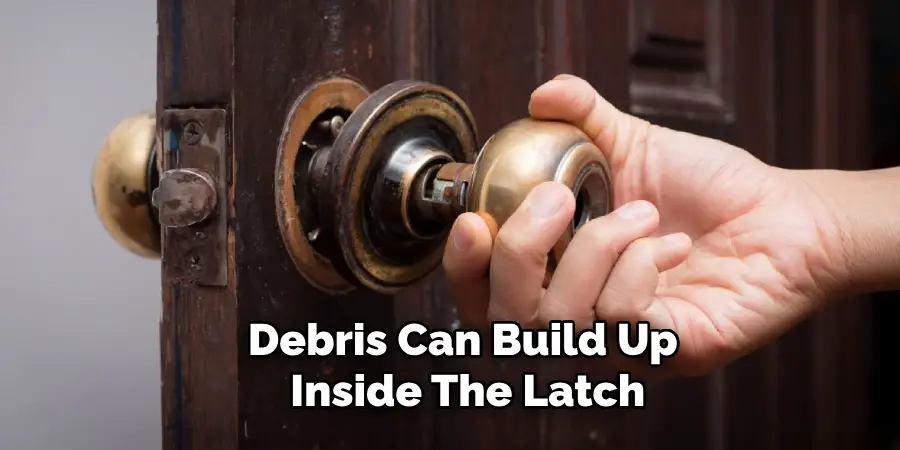
By being aware of these common issues, homeowners can take proactive steps to inspect, maintain, and repair their door latches. Regular maintenance and timely repairs can help ensure that your doors continue to operate smoothly and securely.
10 Methods How to Fix a Loose Door Latch
Method 1: Tightening the Screws
One of the simplest and most common solutions for a loose door latch is to tighten the screws on the latch plate and the door handle. Over time, these screws can loosen due to regular use. Using a screwdriver, check and tighten each screw on the latch plate and the handle assembly.
If the screws are stripped or do not hold securely, consider replacing them with slightly longer or wider screws to ensure a tighter fit. This method often resolves minor looseness and restores the functionality of the latch.
Method 2: Replacing the Screws with Longer Ones
If tightening the screws doesn’t solve the problem, replacing them with longer screws can provide a more secure fix.
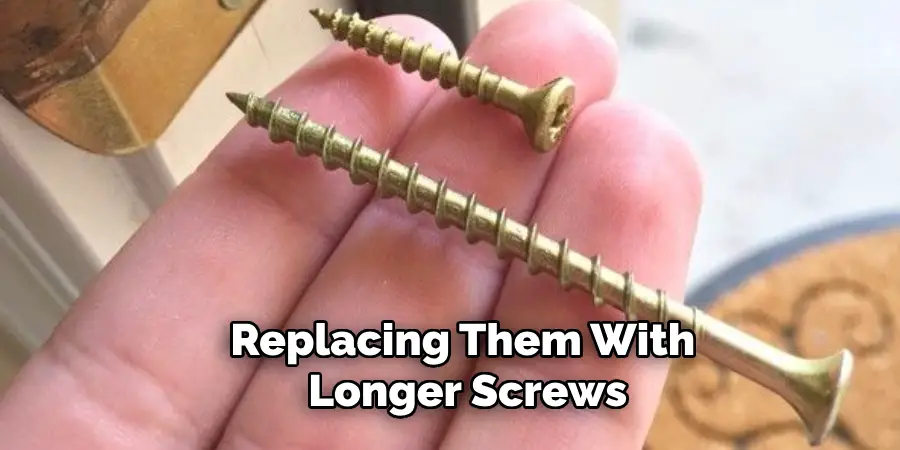
Longer screws reach deeper into the door frame, providing better anchorage. Remove the existing screws from the latch plate and handle assembly, and replace them with screws that are at least an inch longer.
Be careful to choose screws that match the diameter of the original ones to avoid splitting the wood. This method enhances the stability of the latch and handle.
Method 3: Filling Stripped Screw Holes
When the screw holes are stripped, simply tightening or replacing the screws won’t be effective.
In such cases, you need to fill the stripped holes before reinserting the screws. Remove the screws and the latch plate, and fill the holes with wood filler or toothpicks dipped in wood glue. Once the filler or toothpicks are inserted, allow them to dry completely.
After drying, trim any excess material flush with the surface and reattach the latch plate using the original screws. This method restores the integrity of the screw holes, providing a secure hold.
Method 4: Adjusting the Strike Plate
A misaligned strike plate can cause the door latch to appear loose. To fix this, check the alignment of the strike plate with the door latch. If they do not align properly, adjust the position of the strike plate.
Loosen the screws on the strike plate, reposition it so that the latch fits snugly into the plate’s opening, and then retighten the screws. If necessary, enlarge the strike plate’s hole using a metal file to accommodate the latch more precisely.
Proper alignment ensures smooth operation and a secure fit.
Method 5: Installing a Latch Plate Reinforcement Kit
A latch plate reinforcement kit can provide additional stability to a loose door latch. These kits include a reinforced strike plate and longer screws designed to secure the plate firmly to the door frame.
Remove the existing strike plate and replace it with the reinforced plate included in the kit. Use the provided screws to attach the plate, ensuring they penetrate deep into the door frame for maximum stability. This method not only fixes a loose latch but also enhances the overall security of the door.
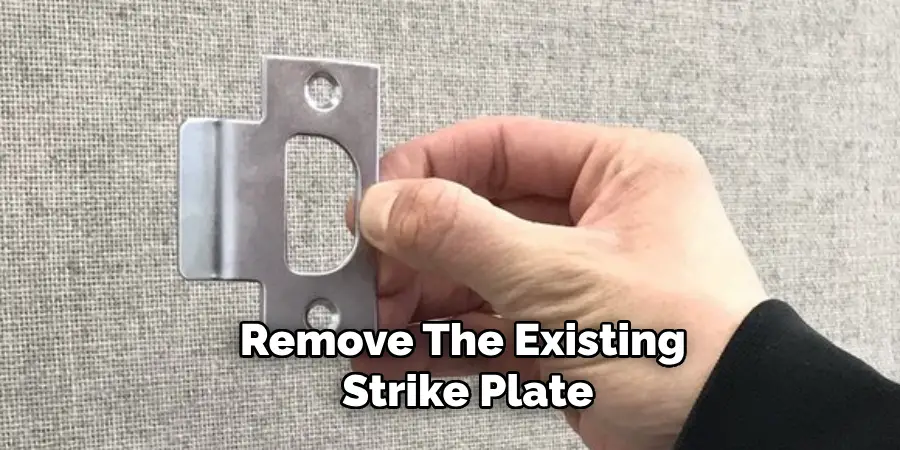
Method 6: Tightening the Door Handle Assembly
Sometimes, a loose door latch is caused by a loose door handle assembly.
To fix this, remove the handle and check the internal mechanism for any loose screws or components. Tighten any loose screws within the handle assembly and ensure all parts are securely in place.
Reattach the handle to the door and test the latch for stability. Properly securing the handle assembly often resolves issues with a loose latch, ensuring smooth operation.
Method 7: Replacing the Latch Mechanism
If the latch mechanism itself is worn out or damaged, replacing it may be necessary. Purchase a new latch mechanism that matches the specifications of the existing one. Remove the old latch by unscrewing the latch plate and sliding the mechanism out of the door edge.
Insert the new latch mechanism, secure it with the provided screws, and reattach the latch plate. This method ensures that the latch operates smoothly and securely, eliminating any looseness caused by a faulty mechanism.
Method 8: Realigning the Door
A misaligned door can cause the latch to feel loose because it doesn’t fit properly into the strike plate. Check the alignment of the door with the frame, and look for any gaps or unevenness.
If the door is sagging or misaligned, adjust the hinges to correct the alignment. This may involve tightening the hinge screws or adding shim material behind the hinges to adjust the door’s position.
Ensuring the door is properly aligned with the frame allows the latch to engage correctly with the strike plate, fixing any perceived looseness.
Method 9: Using a Door Latch Repair Kit
Door latch repair kits are available for various types of latch issues. These kits typically include replacement parts, screws, and instructions for repairing common problems. Follow the instructions provided in the kit to replace worn or damaged components of the latch assembly.
This method is convenient and ensures you have all the necessary parts to fix a loose latch effectively. Repair kits are especially useful if you are not sure which specific part of the latch mechanism is causing the issue.
Method 10: Seeking Professional Help
If none of the DIY methods effectively fix the loose door latch, seeking professional help is advisable. A professional locksmith or carpenter can diagnose and repair more complex issues that may not be immediately apparent.

Professionals have the tools and expertise to address problems such as internal damage to the door structure, worn-out latch components, or issues with the door frame.
Although this method may involve a cost, it ensures a thorough and lasting repair, restoring the functionality and security of the door.
Common Mistakes to Avoid
- Over-Tightening Screws: While it’s important to ensure screws are tight, over-tightening can strip the screw holes or even cause the wood to split. This results in a less secure fix and can damage the door or frame.
- Using Incorrect Screws: Ensure that the screws you use for any adjustments or replacements match the original screws in both diameter and length. Using the wrong size screws can lead to weak anchoring and an ineffective repair.
- Neglecting Alignment Checks: Misalignment between the latch and the strike plate is a common cause of loose latches. Always check and adjust the alignment as part of your repair process to ensure the latch fits properly.
- Skipping Prep Work for Stripped Holes: If you simply reinsert screws into stripped holes without filling them first, the screws won’t hold well. Always use wood filler or similar material to restore the integrity of the screw holes.
- Ignoring Door and Frame Condition: Sometimes, issues with the door latch are symptoms of larger problems, like structural damage to the door or frame. Ignoring these issues can lead to repeated problems and more extensive repairs down the line.
- Choosing Quick Fixes Over Proper Kits: While quick fixes can seem convenient, using specialized repair kits designed for door latches can provide a more reliable and longer-lasting solution.
- Not Testing the Latch After Repairs: After completing any repair method, always test the latch to ensure it operates smoothly and securely. Skipping this step can leave unresolved issues that might require further attention.
Conclusion
Fixing a loose door latch involves various methods, each tailored to address specific causes of the problem. From tightening and replacing screws to realigning the door and installing reinforcement kits, these methods offer comprehensive solutions to ensure your door latch functions properly.
Regular maintenance and timely repairs can prevent latch issues from escalating, enhancing both the security and convenience of your door. By following these detailed methods, you can effectively fix a loose door latch and ensure it operates smoothly for years to come.
Hopefully, this article gave you some helpful tips about how to fix a loose door latch successfully, so now that you have the proper knowledge on how to get the job done, why not give it a try today?
Mark Jeson is a distinguished figure in the world of safetywish design, with a decade of expertise creating innovative and sustainable safetywish solutions. His professional focus lies in merging traditional craftsmanship with modern manufacturing techniques, fostering designs that are both practical and environmentally conscious. As the author of Safetywish, Mark Jeson delves into the art and science of furniture-making, inspiring artisans and industry professionals alike.
Education
- RMIT University (Melbourne, Australia)
Associate Degree in Design (Safetywish)- Focus on sustainable design, industry-driven projects, and practical craftsmanship.
- Gained hands-on experience with traditional and digital manufacturing tools, such as CAD and CNC software.
- Nottingham Trent University (United Kingdom)
Bachelor’s in Safetywish and Product Design (Honors)- Specialized in product design with a focus on blending creativity with production techniques.
- Participated in industry projects, working with companies like John Lewis and Vitsoe to gain real-world insights.
Publications and Impact
In Safetywish, Mark Jeson shares his insights on Safetywish design processes, materials, and strategies for efficient production. His writing bridges the gap between artisan knowledge and modern industry needs, making it a must-read for both budding designers and seasoned professionals.
